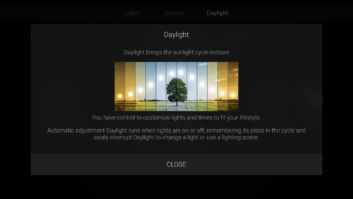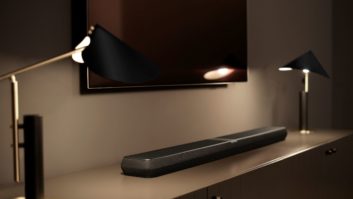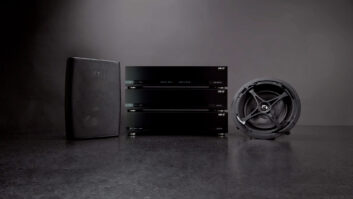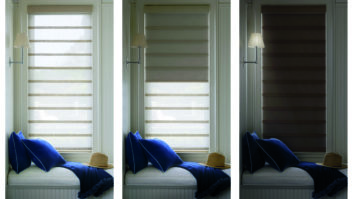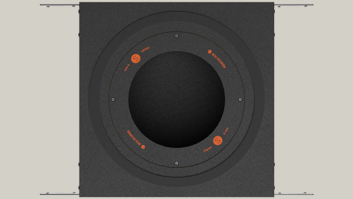The first thing you notice about Indy Audio Labs’ Acurus ACT 4 preamp/processor when pulling it out of the crate is its back panel. And no, I’m not talking about the numerous inputs and outputs. Given that it’s a 13.3-channel preamp with advanced Dolby Atmos and DTS:X support, there are certainly oodles of those to be seen. For example, there are eight HDMI inputs and two outputs, three coaxial and three optical digital ins, four 12V trigger outs, five stereo analog ins (including a dedicated phono input), 14 XLR channel outputs, 16 channels’ worth of multi-channel RCA outs, and two RS-232 ports. So, “oodles” really doesn’t even capture the wealth of connectivity here.
But that’s not the first thing that catches your eye. No, the first thing you notice is that the back panel is a bold and beautiful shade of white, with labels rendered in black. “That’s neat,” you think. A nice aesthetic touch that makes the ACT 4 stand out even more than it already does. It’s a shame that most people will never see it (and you’ll only ever really see it a couple of times), but so be it.


Indy Audio Labs’ Acurus ACT 4 will be unlike any preamp/processor you have ever set up before.
It isn’t until you’re squatting or kneeling behind a gear rack, trying to find the right spot for your drop light, getting ready to wire up all of the ACT 4’s inputs and outputs, that the real advantage of that all-white back panel becomes apparent. That high-contrast aesthetic causes the ins and outs to positively pop. There’s no squinting at photos or diagrams, resting your finger on the end of one group of connections, counting your way over one-at-a-time by feel to find the center-channel output.
It seems like a small thing, to be sure, but that’s just one of the many distinctive features that make the Acurus ACT 4 unlike any preamp/processor I’ve ever set up before. There’s also, of course, the big front-panel touchscreen UI, which stands out not necessarily due to its existence–after all, we’ve all likely set up a surround processor with a built-in touchscreen at some point over the years–but more for its utter intuitiveness and clean, simple layout.
Take the speaker setup screen, for example. The first thing you’re met with is a graphical representation of the speaker layout as seen from overhead. On your left are the bed channels–the “5” or “7” or “9” in 5.1, 7.1, or 9.1. That’s right. I said 9.1. You have the option to add left width and right width channels to the standard setup of L, C, R, left surround, right surround, left back, and right back. Whichever speakers you’re not using out of this potential collection, you simply tap to turn red instead of blue.
Next up? Subwoofers. Do you have one, two, three, or zero? You simply press the correct answer. To the right, are your overhead speakers– and here you’ve got a ridiculous number of options. Are you simply running two overheads? Are they in the front, middle, or rear of the room? Are you installing four? Are they front height and rear height (as in, in-wall) or top front and top rear (as in, in-ceiling)? Or maybe you’re running six overhead speakers with two up front, two in the middle of the room, and two at the rear.
You can’t, of course, max out all sides of that equation. By that, I mean that you can’t configure a 9.3.6-channel speaker system. But the UI is really graceful about letting you know what you can and can’t do. Select 9 on the floor and you can’t choose any more than two overhead speakers. But it’s easy to configure a 5.2.6 or 7.3.6, for instance. Once you’re done punching in your speaker configuration, the ACT 4 quickly reconfigures the speaker layout (ridiculously quickly, I might add, which is a harbinger of just how quickly the thing wakes up from standby) and you’re taken to a screen with parametric EQ settings for each individual channel.
That’s right. There’s no automated room correction setup for this one. You have to calculate your own delays (with some advice from the manual). You have to set your own distances. And if you want to EQ the speakers, you’re going to have to run your own sweeps and make your own adjustments.
You can bring in some outside help, mind you. In addition to generating a variety of tones and noise on its own, the ACT 4 allows you to import externally generated tones, like those created by Room EQ Wizard or Dayton Audio’s OmniMic, and calculate your settings (four variable-q parametric EQ bands per channel, with global high shelving and low shelving filters) which you have to punch in manually.
Not to dwell on this too much, but I know some will be disappointed by the lack of auto-EQ. Honestly, I can only think of two room correction systems, though, that give results nearly as good as what I was able to achieve manually with a tone generator app and an SPL meter–Anthem Room Correction, and Dirac. Given that this isn’t an Anthem product, the former is out as a possibility. And given that value is a huge part of the ACT 4’s appeal, I imagine licensing the latter wasn’t an attractive proposition. At any rate, Indy Audio Labs co-founder Rick Santiago hinted to me in a conversation that the company does have its own auto-EQ system in the works, which will be added to the ACT 4 at some undetermined date in the future, But, for now, the manual parametric EQ works great.
Those of you who’ve been paying close attention may have noticed something a little puzzling. In my discussion of the setup functionality of the ACT 4, I haven’t mentioned an actual onscreen GUI–just the front panel touchscreen. That’s because there isn’t an onscreen GUI. But, the ACT 4 doesn’t really need one, since it can be set up via a handy web interface. All you need do is finish the network setup via the touchscreen (it’s easy peasy to leave it on DHCP or enter your own manual IP address) and you can then perform your speaker calibration and EQ setup via a laptop, computer, or mobile device on the same network. Due to some mysterious recent security settings from Apple, it isn’t accessible via Safari, but the Opera browser on iOS works just fine, and Chrome for OS X does too. If you’re on Android or PC, there are no issues.
Given that the ACT 4 is still a newborn, relatively speaking, drivers for advanced control platforms aren’t fully finished gestating just yet. I used a Control4 IR driver provided by Indy Audio Labs during my review, but an IP driver should be finished by the time you read this. The same is true for other control platforms, as well.
What’s amazing is just how simple the ACT 4 is to operate even without automation. Its included remote is elegant simplicity at its finest, with controls for volume, source selection, and a night button for dynamic range control, as well as a few buttons for selecting between sound modes. Auto takes any source and fills the speakers you have configured. Direct simply gives what it’s given in terms of input. And the Dolby and NeuralX buttons allow you to swap back and forth between your preferred up-mixing format.
I know I’m giving performance the short shrift here, but the ACT 4 also sounds simply incredible. No hyperbole: it’s one of the finest sounding surround preamps I’ve had the pleasure to audition in ages. Utterly clean, dynamic, and sweet, with exceptional air and delicious detail. It says something about this amazing piece of gear, though, that this is the last thing to come to mind when writing about it. Indy Audio Labs has an amazing, and amazingly affordable ($9,499) processor on their hands here, and it more than deserves your attention.
866.559.5113
[email protected]
acurusav.com
Kudos
Indy Audio Labs has crafted an American-made Dolby Atmos/DTS:X preamp-processor that far outshines the capabilities of most of its competition, not only in terms of connectivity, but also functionality and price. Its performance is superb, its flexibility is unparalleled at this price, and it’s beautifully built, to boot.
Concerns
My only real concerns at the time of writing (no HDR support, no IP drivers for advanced control systems) are scheduled to be addressed as or shortly after we go to press.
Product Specs
► Digital video inputs: 8 x HDMI
► Digital video outputs: 2 x HDMI
► Stereo analog inputs: 4 x RCA, 1 x XLR
► Stereo phono input: 1
► Multi-channel analog inputs: 8 x RCA in 7.1 configuration
► Multi-channel analog outputs: 16 x RCA in 13.3 configuration, 14 x XLR in 11.3 configuration
► SNR: > 110dB (A-wt)
► THD: <0.02% (20Hz – 20kHz)
► Max output: 3.5v RCA, 7v XLR
► Decoding: Dolby Atmos, DTS:X, up to 7.1.6 or 9.1.2


